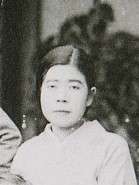Chen Jin (painter)
Chen Jin was born to a noted family in Kōzan, Shinchiku-cho, Japanese Taiwan. In 1922, she entered Taihoku Third Girl’s High School.[1] She was the only well-known female Taiwanese painter before 1945 of the colonial period.[2] Her focus was primarily in gouache painting, with a special emphasis on figures paintings.
Chen Jin | |||||||||||||
|---|---|---|---|---|---|---|---|---|---|---|---|---|---|
陳進 | |||||||||||||
 | |||||||||||||
| Born | 2 November 1907 | ||||||||||||
| Died | 27 March 1998 (aged 90) | ||||||||||||
| Nationality | Taiwanese | ||||||||||||
| Education | Taipei Third Girl's High School | ||||||||||||
| Alma mater | Tokyo Women's Academy of Fine Arts | ||||||||||||
| Occupation | Painter | ||||||||||||
Notable work | The Bridal Chamber (化粧) (painting) | ||||||||||||
| Style | Gouache painting | ||||||||||||
| Television | Is a character in La Grande Chaumiere Violette 紫色大稻埕 (2016 TV series) | ||||||||||||
| Awards | Ensemble was selected for the Imperial Art Exhibition (Teiten) in 1934. | ||||||||||||
| |||||||||||||
Education
Under the recognition and encouragement of her teacher, Gohara Koto, she went abroad to study painting in Japan. By 1925, she was accepted into the Normal Education Division in Japanese Painting at Tokyo Women's Academy of Fine Arts, and began to study under teachers such as Yuuki Somei and Endou Kyouzou. In 1928, she became acquainted with the Taiwan Art Exhibition juror, Matsubayashi Keigetsu. Through his introduction, she became pupil of the Japanese bijin-ga (pictures of beautiful women) painter Kaburagi Kiyokata, and received instruction from Kaburagi’s disciples, Itou Shinsui and Yamakawa Shūhō.
Painting style
Chen Jin’s focus was primarily in gouache painting,[3] with a special emphasis on figures paintings. From 1927 onward, she was selected numerous times for the Taiwan Art Exhibition (Taiten);[3] her work Ensemble was selected for the Imperial Art Exhibition (Teiten) in 1934. Chen's personal style developed gradually. She often explored daily home life and the ideal form of the Taiwanese lady through meticulous brush technique and refined color, in works that reveal the special qualities of elegant ladies from high society. Chen's most famous works exemplifying her style include: Wearing Makeup, Pandanus, Another Day and Quiet Contemplation.
Work and public life
In 1946, Chen Jin served as a juror for the Taiwan Provincial Art Exhibition while continuing to produce her own work. Making a thematic shift, she produced the works Infant, Little Boy, Children’s World, and Familial Portrait to show the family through the eyes of loving mothers and elderly people. Though she tended to focus on figure painting, Chen Jin also accepted a commission from Taipei’s Fa-kuang Temple which led to the production of her series of The Buddha’s Work (1965-1967).
In her later years, she traveled back and forth between Taiwan and the United States. These experiences led to a thematic expansion in her work, which began to include landscape paintings.
See also
References
- Kikuchi, Y. (2007). Refracted Modernity: Visual Culture and Identity in Colonial Taiwan. University of Hawaii Press. p. 127. ISBN 9780824830502.CS1 maint: ref=harv (link)
- Lai, J.Y. (2008). Cultural Identity and the Making of Modern Taiwanese Painting During the Japanese Colonial Period (1895-1945) (Ph.D.). University of Michigan.CS1 maint: ref=harv (link)
- Sullivan, M. (2006). Modern Chinese Artists: A Biographical Dictionary. University of California Press. p. 14. ISBN 9780520244498.CS1 maint: ref=harv (link)